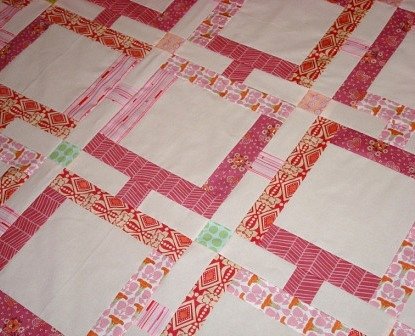
You've finished your quilt top, you know your process and design work, and now you're ready to put your design into words. This may feel tedious at times but this is the most important part of the process. If your instructions are clear, your pattern will be a success.
Pattern steps tend to come in one form or another. You can either provide step-by-step pictures with instructions or you can use diagrams {computer drafted or well drawn illustrations} with step-by-step instructions. A lot of this will depend on the type of quilt you are making.

A more traditional quilt that is made up of blocks is probably best explained using step-by-step pictures showing how to make one block. Show your reader how to make one block and then tell them how many more blocks to make using the same instructions. This is the process I used for my Serendipity pattern.

A more modern quilt that consists of varying blocks and techniques is probably best explained using diagrams with step by step instructions. Break the quilt down into parts, i.e. make 200 HST's. Complete that part and move on to the next part of the quilt, i.e. cut 50 individual 5" solid squares. Finish the quilt with a diagram showing how to construct each row and then instructions for completing the quilt top. This is the process I used for my Chasing Chevrons quilt along as well as my Intersection{s} pattern.

Other things to include in your pattern:
-A list of supplies needed... make this as basic as you can imagine. For example, a rotary cutter and mat may seem like an automatic to you and me but keep in mind that a lot of beginning quilters buy patterns and may not know that tools like these are needed or even exist.
-Abbreviations... I like to define common terms used throughout the pattern. Quilting lingo like RST, HSTs, WOF, seam allowances, etc. are all terms that an experienced quilter knows but would lose a beginner in a second. If there is a technique used throughout a pattern like making half square triangles {HSTs} go ahead and show how to make them. A beginner would really appreciate this! Same thing goes for a scant 1/4" seam allowance... this term frustrated me so much as a beginner because I had no idea what the heck a "scant" was.
-Fabric requirements... This is a big one! You can calculate the yardage needed with a yardage calculator but I haven't found this to be completely accurate. There's also the old fashioned way using pencil, paper and a calculator which is my preferred method. Overestimate a little but tell your reader that you are overestimating just in case they are trying to get by on scraps or bare minimum yardage. Give a disclaimer that your requirements do not account for large cutting or sewing mistakes; overestimating will probably cover some small mistakes but not the big ones.
-One last thing about fabric requirements... make them available without having to purchase the pattern. A lot of quilters, myself included, will shy away from buying a pattern if they don't know how much fabric will be needed. This is especially true if someone is making a quilt from their stash or they are shopping online and want to buy fabric along with the pattern.
-Writing... definitely don't forget about the actual writing. Make sure to use spell check and double check your grammar too!
I hope all this makes sense. If you have any questions please let me know!
PS: I know I was planning on making this a three part series but I'm thinking that four parts will be better. I didn't want to cram writing your pattern and technology into one post. So {part 3} will cover pictures, making a PDF, and finishing up your pattern. {Part 4} will cover publishing, protecting your design, copyrights, etc.